Pure water technology
Pharmaceutical Technology Europe
Traditionally, in pharmaceutical water systems the main method for controlling bacterial levels was heat or chemical sanitants...
Few industries now use untreated tap water in their production processes. Most find it necessary to purify tap water to a greater or lesser extent, as it can vary greatly depending on the source and the season. There are also increasing quality demands on production processes. Many applications where drinking water was previously suitable now require some form of water treatment.
The level of treatment required will alter with the application and the feed water quality. In some 'simple' applications using filtration to remove large particles may be sufficient while other applications require more stringent levels of purification. Even apparently 'simple' requirements, such as the 'spot-free rinse' option in a car wash, requires quite a high water quality with a conductivity of around 10 μS/cm or better to ensure that no salt residues form when the water droplet dries. A similar quality standard is required to ensure laboratory or medical equipment emerges from a washer with no salt residues.
The pharmaceutical, electronics and power generation industries use the highest purities of water. The water qualities required are so pure that if someone touches the water it would contaminate it and could not be used as it would fail the test analysis. The main impurities present in water can be divided into three categories:
- Organic material, measured as total organic carbon (TOC).
- Ionic material, measured by conductivity or the level of individual ions; for example, by ion exchange chromatography (IEC).
- Bacteria.
However, even within high purity water specifications there is some variation in the requirements. For example, pharmaceutical systems require reproducibility, reliability and documentation. Power generation requires very low conductivity and silica levels, and electronics manufacturers require the absence of any measurable impurities. The pharmaceutical industry and healthcare applications, such as renal dialysis, have standards defined by legal specifications outlined in Pharmacopoeias (Table 1). All other industries set water standards to meet the commercial and practical requirements of their manufacturing operations.
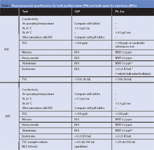
Table 1 Pharmacopoeial specifications for bulk purified water (PW) and bulk water for injections (WFIs).
Modern developments in water purification technologies, such as continuous electrodeionization (CEDI), ultrafiltration (UF) and ozone, have made it possible to achieve even higher purities of water. High purity water systems, such as those used in the electronics industry, are almost 100% pure water, with some impurities being measured in the parts per trillion (ppt) range.
These improvements have also increased the demands on analytical technologies, which are used to monitor these systems, such as TOC and high performance liquid chromatography (HPLC).
Modern water treatment systems
Most water systems consist of three sections: pretreatment, purification and distribution. The pretreatment system is designed to specifically meet the requirements of the site feed water supply and is used to remove impurities that may detrimentally affect the performance of the purification equipment. The purification system removes sufficient quantities of the remaining impurities in the pretreated water supply to achieve the final water quality required. The distribution system, typically including storage tanks and pipework, gets the water to the location(s) where it is required for the production process.
Pretreatment. Much of the technology used in the pretreatment section is based on 'old' technology; for example, ion exchange-based water softening, which has been in use for almost 100 years. However, there is a growing increase in the use of newer membrane-based technologies. Not only are the municipal water companies installing membrane-based systems to help control contaminants, such as Cryptosporidia, but the use of UF membranes in on-site water systems is increasing, particularly where there may be a high organic level in the feed water. These organic materials can be detrimental to the performance of the purification technologies in the purification section; for example, by creating a fouling layer on membranes, coating ion exchange resins.
TOC meters can measure the level of organic material in the feed water, but, unfortunately, there is not always a simple relationship between the TOC level in mains water and the likelihood of this water 'fouling' membranes. Therefore, TOC measurement tends not to be very useful in this section of a water plant. However, reducing the TOC level is usually beneficial to the overall system performance and using hollow fibre UF membranes in pretreatment systems can generally achieve this very successfully. UF membranes typically are considered to have an average effective molecular weight filtration range of 10000–200000 Da equating to a size of approximately 0.005–0.2 μm.
UF membranes are available as spiral-wound modules or as hollow fibre modules. These hollow fibre membranes are usually 'double skinned'; that is, they have a UF membrane on the inside of the hollow fibre and the outside. The design of the UF system typically uses a cross flow configuration, where the feed water is recirculated internally. Permeate is taken off through the membranes and a portion of concentrate bled off to drain with the concentrated impurities.
UF membranes provide a good balance of physical strength, resistance to fouling and 'cleanability' with economically viable flux rates (flux is a measure of flow per unit area of membrane). Figure 1 shows a UF system designed for this type of application. There are various methods of operating such a system, from a high cross flow and lower percentage conversions through to minimal or no cross flow with periodic backpulsing/backflushing and cleaning cycles. The system pictured is designed to operate with a cross flow, but includes the capability of backwashing the UF modules with permeate periodically, as well as performing chemical cleaning cycles.

Figure 1
In this type of pretreatment application, the UF membranes remove contaminants across a wide range of particle sizes and are particularly effective at reducing the TOC levels. The UF membranes used in this application will typically have a molecular weight cut-off rating of 30000–100000 Da.
Purification. Reverse osmosis (RO) has been the key technology in most pure water systems for many years now and this membrane technology is very good at removing a high percentage of all contaminants present, frequently achieving 95–99% removal of ions and over 99.99% removal of organic and bacterial contaminants.
To achieve the lower conductivity specifications required in many applications it is now common to follow the RO stage with a CEDI stage. In pharmaceutical water systems the use of CEDI with RO is now generally regarded as the standard combination to produce purified water or pretreat water for injections (WFIs).
Most commercial CEDI devices comprise alternating cation and anion-permeable membranes with the spaces in between configured to create liquid flow compartments with inlets and outlets. The compartments bound by an anion membrane facing the positively charged anode and a cation membrane facing the negatively charged cathode are diluting compartments. The compartments bound by an anion membrane facing the cathode and a cation membrane facing the anode are concentrating compartments. To assist ion transfer in low ionic strength solutions, the dilute compartments are filled with ion exchange resins. A transverse direct current (DC) electrical field is applied by an external power source using electrodes at the bounds of the membranes and compartments. When the electric field is applied, ions in the liquid are attracted to their respective counter-electrodes. The result is that the diluting compartments are depleted of ions and the concentrating compartments are concentrated with ions. Figure 2 illustrates the typical configuration of a plate and frame EDI system.

Figure 2
During the last few years, there has been a shift towards thicker diluting cells and modular system approaches, both of which have lowered costs. Thicker diluting cells reduce the amount of ion exchange membrane area necessary to treat a given amount of water, thereby reducing the overall cost of the modules. This has led to the use of layers of resin where the layers can be primarily cationic, primarily anionic material, mixed bed and so on.
With layered CEDI technology, the goal of the individual layers is to remove their respective counter ions; that is, the anion resin layers remove anions and the cation resin layers remove cations. To maintain electroneutrality in a layer where cations are being transferred to the concentrate, water splitting must occur at the anion exchange membrane to provide hydrogen (H+ ) ions. A similar process happens in the anion layer at the cation membrane providing hydroxyl (OH– ) ions to replace the removed anions. For this process to happen efficiently, layers must be enhanced to promote the water splitting reaction. In these enhanced layers, the acid or base created through water splitting can regenerate some of the ion exchange resin. It can also change the bulk pH in that particular layer. This is critical to the removal of species that are very weakly ionized at neutral or slightly acidic conditions, typical of CEDI feed waters.
While not designed to remove residual TOC material, the fluctuations in pH through a layered bed system combined with the steady state of operation does result in, at worst, no addition of TOC and, at best, some reduction of TOC. Therefore, on most potable waters, the combination of RO and CEDI can result in product water that has a TOC level of as low as 5–20 ppb and a conductivity as low as 0.055 μS/cm. This technology was also incorporated into some laboratory water systems where a combined RO/CEDI unit produces water that is then further purified by a 'point of use' polisher unit using a combination of polishing technologies. Systems such as this are used to produce water for making up HPLC buffers and TOC meter test solutions.
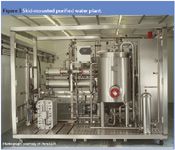
Figure 3
Industrial CEDI modules can be based on a 'plate and frame' design or a 'spiral' design and the resulting module incorporated into a system. Figure 3 illustrates an example of a skid-mounted purified water generation plant showing an LX CEDI module installed (bottom left in picture). Figure 4 shows plate and frame-type CEDI modules and a system of spiral-type EDI modules. The VNX module in Figure 5 is one of the latest CEDI developments, in which the 'plate and frame' concept is manifolded within a single housing, providing high flux in a compact unit.
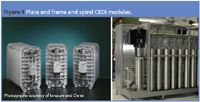
Figure 4
Distribution. Traditionally, in pharmaceutical water systems the main method for controlling bacterial levels was heat or chemical sanitants, such as peracetic acid or hydrogen peroxide. However, for systems operating at ambient temperatures there is now an increasing trend to use ozone in the distribution system to continually control bacteria. Using ozone also provides the additional benefit of reducing TOC levels in the product water. In most European pharmaceutical water systems, ozone is generated from a small side stream of water using an electrochemical method. In this system, the water is electrically split into hydrogen and oxygen. The oxygen is then converted into ozone and the ozone-rich water stream is fed into the return flow at the end of the distribution system. In this way, a residual ozone level is built up in the storage vessel and the ozone is then destroyed by an ultraviolet (UV) light as it enters the distribution loop. The pipework system may be sanitized by periodically turning off the UV light and allowing ozone to circulate around the distribution loop.
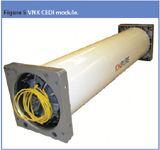
Figure 5
Ozone is a very powerful oxidizing agent and works by attacking carbon–carbon bonds in any organic material. As this procedure continues, all the carbon chains can be broken down and the carbon produced is converted to carbon dioxide. This further reduces TOC in the product water and is a by-product of the use of ozone in pharmaceutical water systems because the TOC is already typically substantially less than the maximum allowed level of 500 ppb. However, it is one of the primary reasons for using ozone in a microelectronics water system where the objective may be to get to <1 ppb TOC levels.
Monitoring instrumentation
HPLC. HPLC is used to separate components of a mixture based on a variety of chemical interactions between the substance being analysed (analyte) and the chromatography column. There are four general types of HPLC:
- normal phase
- reverse phase
- size exclusion
- ion exchange.
When monitoring water systems the only type commonly used is IEC — the others may be used to separate organic compounds to help identify specific contaminants, but this procedure is more likely to be used in specialist problem-solving situations rather than routine monitoring.
IEC is a process that allows the separation of ions and polar molecules based on the charge properties of the molecules. It can be used for almost any kind of charged molecule. IEC retains analyte molecules based on coulombic (ionic) interactions. The stationary phase surface displays ionic functional groups that interact with analyte ions of opposite charge. This type of chromatography is further subdivided into:
- Cation exchange chromatography, which retains positively charged cations because the stationary phase displays a negatively charged functional group, such as a phosphonic acid.
- Anion exchange chromatography, which retains negatively charged anions using a positively charged functional group, such as a quaternary ammonium cation.
IEC is rarely used in monitoring pharmaceutical water systems, but it may be used in monitoring electronics water systems where the level of ionic contaminants may be in the part per trillion (ppt) range and the quantification of individual ions may be of interest in monitoring the performance of the purification system.

Key points
TOC. TOC analytical instruments measure the level of TOC present in the water. A typical analysis for TOC measures both the total carbon (TC) present, as well as the inorganic carbon (IC). Subtracting the inorganic carbon from the total carbon yields TOC. Another common variant of TOC analysis involves removing the IC portion first and then measuring the leftover carbon. This method involves purging an acidified sample with carbon-free air or nitrogen prior to measurement, and so is more accurately called nonpurgeable organic carbon (NPOC).
Virtually all TOC analysers measure the CO2 formed when organic carbon is oxidized and/or when inorganic carbon is acidified. Oxidation is performed by a variety of methods: short wavelength (185 nm) UV lights, platinum (Pt)-catalyzed combustion or a UV/persulfate reactor. Once the CO2 is formed, it is measured by a detector: either a conductivity cell (if the CO2 is aqueous) or a nondispersive infrared cell (after purging the aqueous CO2 into the gaseous phase). Conductivity detection is only desirable in the lower TOC ranges in deionized waters and is the method normally used by instruments in high purity water systems. In contrast, nondispersive infrared (NDIR) detection excels in the higher TOC ranges. A variation described as membrane conductivity detection (MCD) can allow for measurement of TOC across a wide analytical range in deionized and nondeionized water samples.
Modern high-performance TOC instruments are capable of detecting carbon concentrations well below 1 μg/L (1 ppb). This type of system can be quite expensive and, in a pharmaceutical application, requires additional validation documentation, routine system suitability testing and calibration.
In high purity water systems arguably the best approach is to have the TOC meter fed continuously with a stream of water from the system being monitored; that is, operating on-line. This allows almost instantaneous monitoring of the TOC values, which can assist in trouble shooting system problems or identifying possible problems before they can affect the system. For example, an increase in TOC values may precede an increase in bacterial levels because the higher TOC levels indicate that more nutrient is available to support the growth of bacteria. The specification for purified water or WFI is <500 ppb and most modern systems can routinely achieve <30 ppb, significantly better than the design limit. It is typical for electronics water systems to produce water, at the points of use, with 1 ppb TOC or lower. However, pharmaceutical water systems based on using regenerable deionization systems rather than RO can sometimes struggle to achieve the <500 ppb limit when the TOC levels in the mains water are high. This is because there are no organic reduction technologies as effective as RO or UF.
Summary
Modern water systems using the appropriate combination of technologies can reliably achieve very high levels of water quality. For electronics water systems the level of purity is almost limited by the accuracy of the monitoring devices available. For pharmaceutical water systems standard skid-mounted systems are available that can be fully factory tested and most of the validation work completed prior to arriving at site. On site they can be connected and commissioned with a reduction in the time and effort required.
Modern instrumental techniques, such as TOC and HPLC, combined with programmable logic controllers, have substantially altered the way in which water systems are monitored and controlled. In many cases, it is no longer necessary for anyone to visit a water system plant room, except to perform routine functions, such as adding granular salt.
The typical pharmaceutical water system has changed substantially during the past 20 years, in both the technologies used, and the way in which the systems are monitored and controlled. Water systems have consequently become much more reliable and the water qualities achievable have become higher.
Steve Willis is business manager (Europe and India) for Ionpure Products and Services — part of Siemens Water Technologies. His experience in the water industry includes 28 years in the industrial water sector, supporting markets such as pharmaceutical, power, chemical, microelectronics and laboratory water throughout Europe and the Middle East.
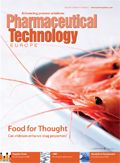
Drug Solutions Podcast: A Closer Look at mRNA in Oncology and Vaccines
April 30th 2024In this episode fo the Drug Solutions Podcast, etherna’s vice-president of Technology and Innovation, Stefaan De Koker, discusses the merits and challenges of using mRNA as the foundation for therapeutics in oncology as well as for vaccines.